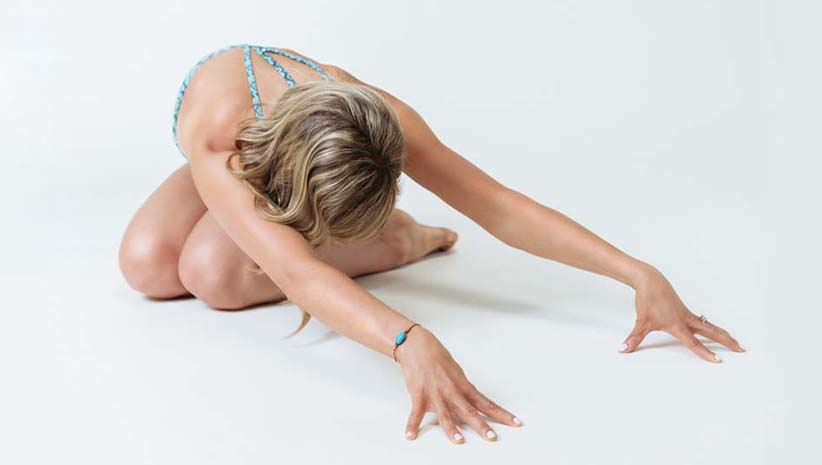
Yoga is effective for reducing shoulder pain, reducing stress, boosting immunity, improving circulation and mental focus, and increasing vitality. I know this to be true.
A long time ago (2004) in a far-away land (New York City) I had a vision that teaching yoga would be a quiet, peaceful, and tranquil career in guiding mindful souls to spiritual enlightenment.
Fast forward to the reality of braving rush hour and crossing freeways to share my passion – to inspire an awakening within my students and help them access their highest self.
We all build careers, nurture families, foster friendships, finance lifestyles, and juggle myriad responsibilities. It’s stressful, especially when multi-tasking has become a standard way of life.
One of the places in the body where we habitually hold this stress is in the shoulders and upper back. Hours of hunching over computer screens and cell phones can lead to a buildup of shoulder pain, tightness, stress, and tension.
The burden of this unending cycle can feel overwhelming. Releasing our mental, emotional, and physical stress helps us maintain and even thrive amidst life’s challenges. These days, more than ever, we need the peaceful and unifying power of yoga to empower our practice well beyond the physical asana — to penetrate our heart, our soul, and our lives.
Here are some of my go-to shoulder savers for shoulder pain.
Eagle Arms
- Standing tall, bring your arms in front of you at shoulder height, palms turned upward
- Cross the right elbow over the left, then bend your arms
- Bring the palms up to 90 degrees with the backs of the hands touching
- If it is available to you, try touching your palms together
- Mindfully create a stretch through healthy opposition by pressing the shoulder-tops away from the ears as you lift the elbows
- Continue to stretch the back body by guiding the forearms away from you
- Repeat on the other side, left over right
Benefits: The energy of eagle arms moves the rhomboids, posterior deltoids and the top and back of the trapezius through a range of motion different from our habits, allowing us to stretch, relieve shoulder pain, and release tension.
Awareness Tip: This pose assists in introspection. With our hands blocking our external drishti (gaze or focal point) we are guided to turn our gaze, and thereby our attention, inward.
Dancer
- Standing on your right leg, bend your left knee, and reach for the inside of your foot with your left hand
- From here, lift and expand the upper chest and reach your right arm upward
- Hinge from your standing right hip and hug the muscles of your standing leg and hip in for support
- While continuing to lift the front of the chest, create strength by imagining the foot is trying to escape the hand, engaging a deeper stretch across the front of the shoulder and along the hip flexor
- Repeat on side 2
Benefits: This is the ultimate posture of expansion, balance, and self-expression, which are important qualities for building vitality. When we engage the muscles while in the pose, it trains the core and encourages joint stabilization.
Awareness Tip: Dancer offers us an opportunity to express ourselves; as we expand the body physically, we expand into the truth of our being, celebrating everything we are in this moment.
Child’s Pose with Arms Extended
- Kneeling with your knees slightly wider than your hips, drop your hips toward your heels
- Hinge forward and lengthen your spine
- Reach out to rest your palms and forehead gently on the mat (support as needed)
Benefits: Child’s pose is an opportunity to rest, allowing us to release the frenzied energy of multi-tasking and tension. It calms the nervous system and allows a passive stretch of the lumbar spine, particularly the upper back, and helps to alleviate shoulder pain.
Awareness Tip: The shape of child’s pose evokes a gesture of honoring through the prostration and bending forward. One way to reduce stress is through recognition. Here, we honor ourselves in a physical gesture of self-love.
Child’s Pose with Side Stretch

- Find child’s pose
- Drop your hips to the right of your heels as you reach your arms to the left
- Take 5-10 breaths then switch sides
Benefits: Stretching away from the opposite hip lengthens and creates traction in the side body, allowing us to release shoulder pain and pent-up tension, and promote full-body mobility by stretching the obliques, the lats, the outer hips, and the IT bands.
Awareness Tip: This restorative stretch allows us to practice the idea of uttita – which means “to reach,” reminding us that we are not meant to play small, but to take up space in this world by living fully and vibrantly, yet compassionately.
When we remember that we are playing in a field larger than ourselves, when we remember our higher purpose, we feel less attachment to minor frustrations and are able to release the associated stress.
Seated Side Stretch
- From a tall seated position, bend your left knee
- Bring your left foot toward the midline of your body, dropping the knee open while extending your right leg wide
- Reaching your left arm skyward, extend your spine as tall as possible
- Lengthen both sides of your waist, and leaning toward your extended right leg
- Repeat on the second side
*If you can keep you heart turned upward, you may have the space to drop your right elbow inside your right leg, and begin reaching your left hand toward the right foot.
If you can find the bind by touching your right foot, utilize this action to rotate your heart toward the sky, in a full-body gesture of openness.
Benefits: This pose provides external hip rotation, side waist mobility and chest opening.
Awareness Tip: Here, we learn about binds, which are unsafe and dangerous if they turn our heart down or close it off. In life, the binds we enter include relationships with our work, our friends, our partners, et cetera.
Binds in life, much like those in our practice, only benefit us if they open the heart and turn it upward. Maintaining an open heart and a generous attitude keeps the tension of resentment from building up in our shoulders and upper back.
Seated Twist
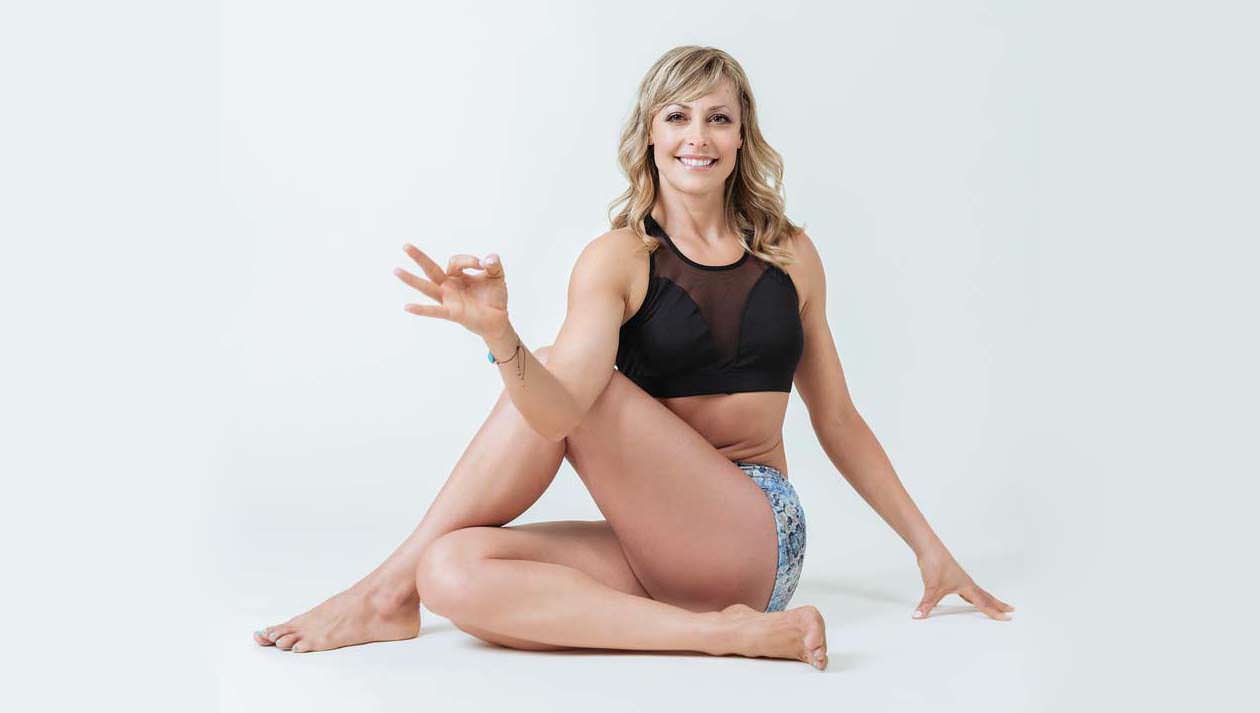
- From a tall seat, bend your right knee open with the foot near the left glute
- Plant your left foot outside your right thigh with knee bent upward
- Twist your torso to the left tucking the right tricep outside of the left thigh.
- Use your breath to self-adjust
- On each inhalation, grow taller through the spine and up through the crown of the head while settling and grounding your seat
- On each exhalation, feel more extension and twist as appropriate
- Repeat on side 2.
Benefits: Twists are powerful poses to activate spinal mobility. Because they place gentle pressure on the digestive organs, they can also aid in elimination.
Awareness Tip: Take a cue from the body and focus on eliminating any waste from the mind and heart. We needn’t carry around every mistake or disappointment we have accumulated.
When we do, it creates additional stress in our bodies. Twist out all the negativity and self-judgement that waste valuable energy.
Bridge
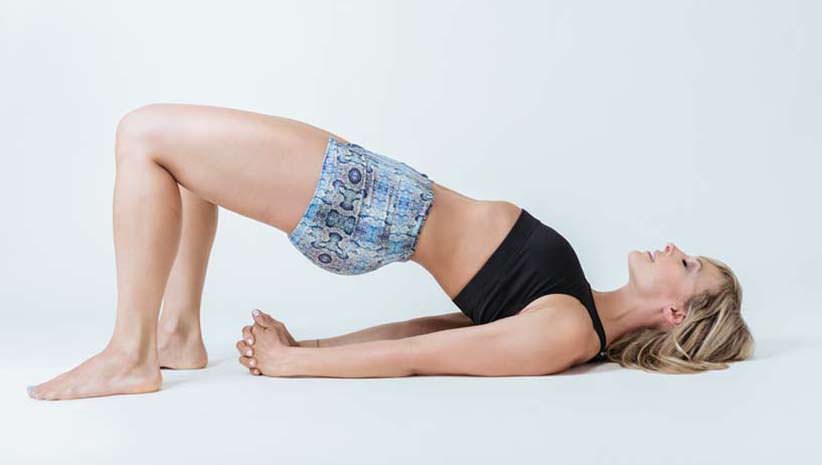
- Begin in a supine pose with knees bent
- Feet plant, arms palms down by your sides
- Mindfully lift up through the hips
- Lengthen your lower back and the thoracic spine as well as the fronts of the thighs and the hips
- Allow the front of the chest to reach skyward
- Drop your chin stays toward your chest, lengthening your cervical spine
Benefits: One of the ultimate heart openers, this classic pose stretches the muscles of the front of the body. It is a counter-pose to the shape of the body in stressful activities that cause shoulder pain, such as driving or hunching over a desk.
Awareness Tip: Channel the energy of this pose and use it to renew a commitment to remain open and steady in order to create the best life possible.
Seated Forward Fold
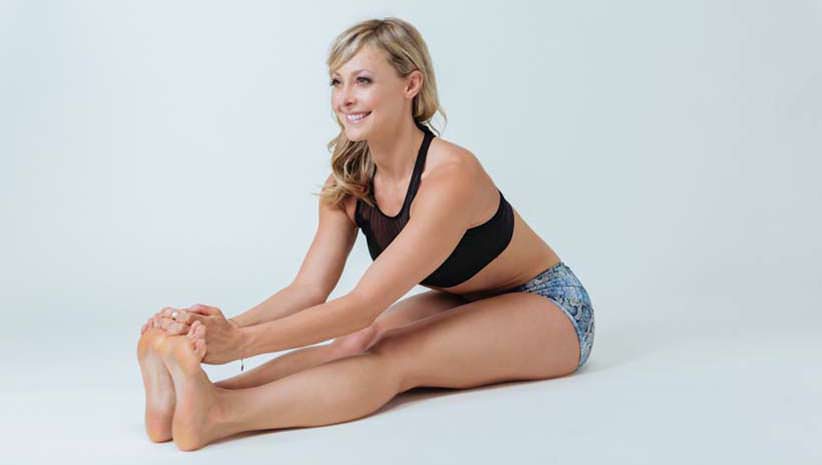
- Begin in a tall comfortable seat with both legs extended in front of you, feet flexed
- Lengthen your spine and hinge from the hips (rather than rounding over from the mid back)
- Keeping your heart elevated, begin to walk your hands toward your knees
- If you have the space, continue to reach toward your toes
- Inhale, contemplate lengthening the space between each lumbar vertebrae
- Exhale, draw the navel to the spine connecting to your core
- Hinge more if available
Benefits: A forward fold creates traction through the entire back of the body; this pose of surrender also helps us to let go and release shoulder pain and whatever other tension we may be holding in the neck and shoulders. I find that this pose helps to calm the central nervous system and release stress.
Awareness Tip: Allow this posture of release the opportunity to help find joy in the surrender. Simply letting go can be the most therapeutic action to decrease mental and emotional stress.
Standing Half Forward Fold
- Stand tall with your feet a gentle hip-width distance apart
- Leading strongly with your heart center, hinge forward from the hips, keeping the low back long and strong while engaging all of the muscles of the core
- Inhale, lead with the heart center reaching forward
- Exhale, draw the navel toward the spine creating core strength and connection
Benefits: The half forward fold is a core strengthening and balance pose that allows us to expand the space around the heart.
Awareness Tip: This pose is a physical metaphor for the crux of our practice: When we lead with our heart while being connected to our strong center, we move forward in power, strength, balance, peace and wisdom.
Squat
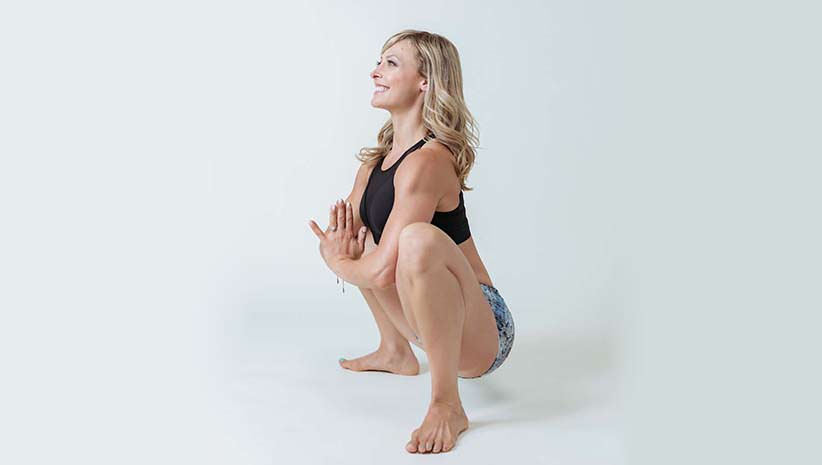
- From a standing straddle, bend both knees and drop your hips
- If you need support, place something underneath the heels
- Draw the palms of the hands together
- Press the elbows outward toward the thighs while pushing the thighs into to the arms
Benefits: The dynamic tension in this pose allows for a heart-opening expansion through scapular retraction. This stabilizes the shoulder girdle, while allowing for a stretch across the anterior deltoids (front shoulders).
Awareness Tip: A squat is essentially a standing version of happy baby – encourage the lungs to expand and breathe in some joy! It is a wonderful posture to counteract the shoulder pain caused by the habitual hunching forward that comes with constant attention to devices like smartphones and computers.
Credits
Lindsey Childs is a photographer specializing in lifestyle portraiture and fine art photography. She has a studio in Venice where she is assisted by Adam Arlit.
Hair and Makeup by Jeannie Jeffries.
Elise clothing by Solo Sol Movement.
Elise Joan was filmed during this shoot for an episode of Yoga Girls which premieres Sunday, September 24 at 8pm ET on Z Living.
Elise Joan is an LA yoga teacher who teaches at Equinox and Exhale (among other locations). She has a yoga/fitness site that allows users to create yoga and workout playlists from 10 minutes to two hours. www.elisejoanfitness.com
